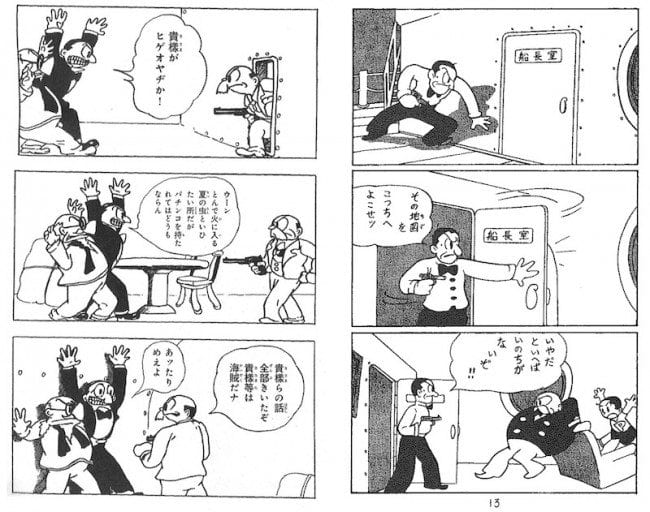It is truly unfortunate for the history of manga that Sakai died in 1969, before the droves of baby boomer manga otaku could surround him and extract more of his story for their magazines and fan dōjinshi. Meanwhile Tezuka, who died in 1989, had twenty-years worth of additional opportunities to tell his side, and a “god-of-manga” reputation to see that his version was ensconced as the official one.

Without getting into everything Tezuka said, most often cited is probably the afterword to the remake of New Treasure Island in 1984. “Sakai Shichima is credited with the original idea [gen’an] and the composition [kōsei], and me with the drawing [sakuga]. However, the original idea aside, I had already created a rough sketch of the composition, 250 pages long. Due to circumstances with the publisher, Sakai reluctantly cut sixty pages, changing the dialogue in addition, and some of the drawing.” That he redrew Tarzan’s face in a less “manga-esque” style was Tezuka’s most specific complaint.
Even the story idea (the manga’s most conventional feature) he wasn’t willing to cede. Earlier, in 1969, Tezuka claimed that the idea of collaboration had arisen after showing Sakai one of his own wartime practice works. Scholars assume this to be Old Man’s Treasure Island (Oyaji no takarajima, 1945-46), based on the fact of a shared “treasure island” theme and a few scenes that appear to have been recycled.

All fingers point to Tezuka. Did Sakai do anything but get in the way?
The credits on the cover of the manga themselves are of little help. Sakai is credited with the “story” (gensaku) and “composition” (kōsei); Tezuka with “drawing” (sakuga). Even if one were to take these credits at face value, it is impossible to say exactly where “composition” ended and “drawing” began. While “kōsei” can be interpreted to mean sketchy thumbnails, it could also mean detailed breakdowns. Similarly “sakuga” might be taken to mean the entirety of the drawing process, the fleshing out of someone else’s rough pencil outlines, or just inking.
There is a Sakai side of the story, even if it is a molehill to Tezuka’s mountain of words. In “A Study of New Treasure Island,” Nishigami Haruo claimed (again, on the basis of talking directly with the aging artist) that Sakai had “thought out the panel breakdowns for each scene (the plot), then passed the baton to Tezuka Osamu. To the finished product, Sakai added the cover and the frontispiece. Thus one can say that Sakai Shichima was the father of New Treasure Island.”
Similarly, in an interview with Nakano Haruyuki circa 1990, Osaka Tokio, editor of Manga Man and a close colleague of Sakai’s in the 40s, wondered, “Why didn’t Sakai just finish the book after drawing so much of it, that’s the real mystery. He drew the cover and the frontispiece, y’know. Probably he felt half like he wanted to help out a young artist. I wonder if he wasn’t thinking about setting up a studio of specialized artisans, working as his disciples. But Tezuka was a young and talented man with lots of ambition, so he had different ideas from the get-go.”
And that is where Sakai’s defense rests. Nothing like a dead witness to speedily end a trial. Nothing like power, publicity, and status to move judgment unilaterally in one’s favor. Thanks in large part to Nakano Haruyuki’s book, however, I think it is now recognized that Tezuka was less than generous in redistributing credit. It would require a close comparative analysis of both artists’ work from that period to get any further with attribution. Instead let me build on what I have already written and argue Sakai’s case circumstantially.
With Sakai’s death, it was not only his own hand that was silenced. There were Disney comics floating around Tezuka and Sakai’s workspaces in the days and months of New Treasure Island’s inception. Tezuka notes it in his diary, in passing. From the little testimony available, the Sakai camp seems to have been more about open this fact. To me, the way in which these American comics were processed in New Treasure Island suggests the directing vision of someone with a specific kind of professional background.
(Continued)






